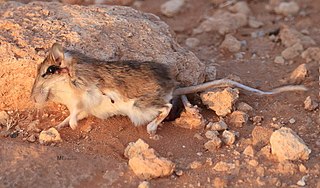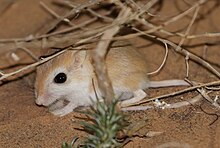
Gerbillinae is one of the subfamilies of the rodent family Muridae and includes the gerbils, jirds, and sand rats. Once known as desert rats, the subfamily includes about 110 species of African, Indian, and Asian rodents, including sand rats and jirds, all of which are adapted to arid habitats. Most are primarily active during the day, making them diurnal, and almost all are omnivorous.
The pleasant gerbil is a species of rodent found mainly in Libya and Egypt, and possibly Mauritania to Tunisia. This species is about 6 cm in body length, with a brown agouti-style coat, a white belly and a very long tail. It is also known as the charming dipodil.
The principal gerbil is a species of gerbil distributed mainly in Sudan; Jebel Meidob; El Malha. Fewer than 250 individuals of this species are thought to persist in the wild.
Harrison's gerbil is a gerbil, a small mammal in the rodent order. It is distributed mainly in the Tigris-Euphrates Valley in Iraq and western Iran. It is also known as the Mesopotamian gerbil.

Cheesman's gerbil is a small rodent in the subfamily Gerbillinae of the family Muridae. It is distributed mainly in Arabian Peninsula to southwestern Iran. It has orange-brown fur, white underparts, large eyes and a very long tail.
Anderson's gerbil is a species of rodent distributed from Tunisia to Israel. Their habitats and diets are similar to other gerbils. The gestation period is 20–22 days and the average litter size is four or five. The IUCN formerly listed the junior synonym Gerbillus allenbyi as vulnerable.

Tarabul's gerbil is a species of small rodent which is found in arid regions of north western Africa.

The pale gerbil is endemic to Egypt and is distributed mainly in the northwestern part of the country. It is also known as the pallid gerbil. The pale gerbil has pale orange fur, with white underparts, white forelimbs and white feet. The ears are unpigmented and the soles of the feet are haired, which is a characteristic of sand-dwelling gerbils.

Gerbillus is a genus that contains most common and the most diverse gerbils. In 2010, after morphological and molecular studies Dipodillus was ranged as a subgenus of Gerbillus, however some taxonomic authorities continue to separate them.





